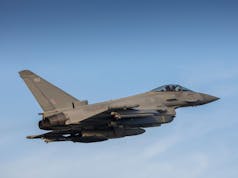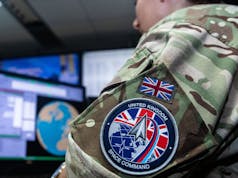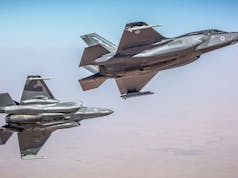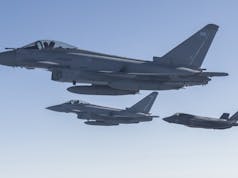The Royal Navy’s Wildcat helicopters are set for a significant upgrade with the acquisition of Martlet missile systems in a £176 million deal, according to a press release.
The new missiles aim to enhance the helicopters’ capabilities against threats ranging from drones to small, fast attack boats.
The Martlet missiles, each weighing only 13kg, were first deployed at sea during the UK Carrier Strike Group’s mission in 2021. They have since been used in operations in the Middle East, protecting commercial ships from attacks by Houthi rebels in the Red Sea. The missiles have also been supplied to Ukraine to aid in its defence against the Russian invasion.
In a Royal Navy news release, Commander Alasdair Lang, Wildcat Maritime Force Commander, underscored the importance of the new missile systems, stating that they are essential for maintaining the Wildcat helicopters’ leading role in attack capabilities. “The Martlet Missile is crucial in ensuring the Wildcat helicopter remains at the forefront of the RN’s attack capabilities, supporting the protection of shipping and countering more general threats to UK interests across the globe,” Lang said in the press release.
The procurement was managed by Defence Equipment and Support (DE&S), the Ministry of Defence’s procurement arm, which finalised the order with Thales UK for their lightweight multirole missiles.
These systems will be used by the Royal Navy and the British Army’s Stormer combat vehicles to bolster short-range air defence capabilities.
Maria Eagle, Minister for Defence Procurement and Industry, announced the order at the Farnborough International Airshow. She emphasized the necessity of maintaining robust defence capabilities in a volatile world, stating, “In a more dangerous world, we must continue to provide weapons to Ukraine but also replenish our own stocks. Our new order of Lightweight Multirole Missiles from Thales UK will support this, providing our Armed Forces with versatile missiles that can be used against threats such as drones, helicopters, and small maritime targets.”













One of the often over looked capabilities of the royal navy is the Lynx and its range of anti ship missiles. Very few navy’s have a similar capability. It proved to be absolutely lethal against the Iraqi navy in 91 and now the Russian Navy is primarily corvette based I could imagine it being just as lethal. Especially in the confined waters of Norway, the Baltic and Black Sea.
What anti ship missiles?
Jim doesn’t know what an ASM is, he makes it up as he goes along – in case someone might not notice
Lynx helicopter that outperformed other naval helicopters by some margin!
I think he’s probably thinking of Sea Venom, which is currently IOC, with LMM I suppose a small boat weapon.
Most helicopters that operate from escorts may be able to use hellfire or equivalent, but not as many have something on the Sea Venom range, which carries a 50 kg warhead.
Iraq – Sea Skua
Not sure would classify as a anti ship weapon. They managed to damage one and sink another mine hunter using a large number of missiles. Not sure would have worked well against anything armoured or large.
Skua had a very high hit rate in GW1. I know of one that went very rogue and decided to do an impression of an Anti aircraft missile on launch but that was about it.
A couple of skua with their SAP warheads into anything FF/DD sized would mission degrade or mission kill it. There were plenty of engagements and damaged/sunk ships from skua at the end of GW1.
However relatively low range and it needing target illumination where an issue. Hence now Venom with IIR homing that can be cued from the EO system on a Wildcat making it a fully passive system.
My concern isn’t their accuracy but their ability to do meaniful damage, which from what I have read is questionable. A large number was required to take out a mine clearer which won’t be armored. Up against anything with it’s own defenses, a wildcat isn’t going to get the time to fire off large numbers.
Skua was made to hit FAC …things like OSA and Tarentul type vessels.
You don’t need to sink something to mission kill it. In fact, a mission kill is preferable to a sinking in the same way that a wounded soldier is preferable to a dead soldier.
They need resources to recover them leaving those resources also open to attack.
If recovered, they need resources to repair them tying up equipment and manpower.
Venom with its IIR homing and data link can attack specific areas, something skua could never do. In effect you can aim it at critical areas to get a mission kill. What good is an Air defence asset without a radar? An ASW asset that has had the engine room hit?
Falklands -Sea Skua and not even cleared for use then!
Technically a Wildcat, as all the Lynx were pensioned off. The Wildcat does have some issues. Mainly due to the additional requirements that is being asked if it.
On a brighter note. Wildcat now has MBDA’s Sea Venom. Which is currently set at IOC, but will hopefully be FOC towards the end of this year/beginning of next year.
Sea Venom will be a step change in capability compared to Sea Skua. As it’s a true stand-off fire and forget weapon. Unlike the Lynx’s Sea Skua. Thereby making life a lot easier for the Wildcat crew.
Technically, Wildcat ..pensioned off? 🤔. Please explain further.
The FAA’s Lynx Mk 8s were replaced by the Wildcat, which officially entered service in 2015. Although they look similar, Wildcat is a new improved design.
Sorry, somehow misread your first sentence. Understood. Thanks. 👍
Sea Skua is out of service. Wildcat have had no missiles to fire i think.
Only the Italians with Marte, i am not sure French retained the Exocet, the USA with Penguin/Hellfire have maintained a capacity.
Venom is at sea on certain vessels
Martlet is at sea.
Thanks for sharing you beat me too it.
French never used Exocet from helos. The Indian’s did, and used Sea Eagle from Sea King. A couple of other ME and Asian nations did as well.
Large AShM from helos is usually a bad idea….they cut the range back significantly so have marginal use case…that might change with NSM-H, which whilst not a true heavyweight does have a significant warhead and range.
Hmm. What has gone wrong with Sea Venom, successfully tested in 2017 but now with IOC delayed until 2026? With Sea Skua out of service, the Wildcat has for the time being very limited firepower.
From Wikipedia:-
“The Royal Navy declared Sea Venom an initial operating capability in May 2021 when it deployed them as part of United Kingdom Carrier Strike Group 21 on its maiden deployment to the Pacific.
The missile equipped four Wildcat HMA2 helicopters embarked on the strike group’s accompanying destroyers. However, in 2023 it was reported that integration challenges were ongoing and as a result, full operating capability would be delayed until 2026”
I’m still puzzled. If the integration problems haven’t been solved, does it actually work yet? According to a French website, it hasn’t been integrated on any of their helicopters because of integration issues.
Was the CSG exercise just a bluff? It’s hard to believe they were expected to work properly in 2021 but won’t reach FOC until 2026.
Too many integrations
It’s possible that the application program interface (API) is technically supported so that all functions are enabled but that the full features are not active while the Wildcat isn’t able to do its full function.
This would be consistent with a missile software test effort that exercises the full functions by calling each API required in turn. Thus the test tools are a virtual launch aircraft along with the plan, execute, record functions required to assure the full functions.
So the missile producers have a very clear definition of the functions and what the launch aircraft needs to do in order to clear their design, build and test milestones.
Given that clarity, required for IOC, it’s surprising that the launch aircraft producers haven’t delivered the defined functions to complete the test and deployment of the full functions. Obviously actual design build and test is hard but having a proven subsystem to integrate including the test suite does enable that significantly.
This is just the engineering perspective and there are commercial and political aspects too. No dosh, no wizz bosh.
Thanks. I did wonder if the man in the loop mode was the problem. Integrating a fire and forget missile shouldn’t cause problems that will have taken 5/6 years to solve.
All a far cry from MBDAs claim that because Sea Skua and AS15 had similar characteristics, integrating SV wouldn’t be a problem.
5 to 6 years could just be down to lack of budget to fix the problem. Its a common tactic used by the MOD delay repairs/ upgrades etc as long as possible hoping for some budget flexibility in a future year.
Yes, let’s change things up w/ a few derivatives. 😉 (Sorry, couldn’t resist. 😁)
Yes it works that’s the difference between IOC and FOC, works but it’s missing capability
Full capability on Wildcat will be flying a mixed load of available weapons and extras. So Venom+ Martlet on either side Or Venom+Stingray or all the other combos. That also includes getting the SHOLs done for landing and take off at various weights and various angles in various sea states on deck. It usual practise to do relative landings (Helo facing Red /Greeen 45 ish)with weapons pointing outboard until the safe pins are in. Accidentally launching a missile into a hangar and the TAS mag would be bad! Once the weapon pins are in and the weapon carrier is pinned, the helo slew rotates on the deck lock (Harpoon) to fore and aft.
It also includes having the magazine stowage racks altered to take the new missile and the handling system modded to lift and shift it.
Aircrew training and certified to fly and fire it.
FAA Bomb heads certified to prep and load it onto the aircraft.
Onboard mag systems certified .
WE Dept storage of the weapons.
WE Weapon Supply Party training and certified to move into and out of the mag.
Emergency procedures if its involved in an incident.
DOAS actions and responsibilities shore side for maintenance and handling.
Think systems of systems, not individual actions, or components of systems to achieve FOC
The main French platform for Sea Venom will be the H-160M Guepard…which hasn’t entered service yet. As a result their need for it hasn’t really arisen yet. No point getting it certified on Panther (Dauphin II) as that will be out of service in the near future. As for NH90…I guess no-one wants to enter that imitation of hell any time soon….
Sure I saw a photo of a Wildcat carrying one on Twitter the other day.
If they’re IOC they can clearly fly with them- and launch them. It could be that they’re limited in how many they can carry at the moment, or splits in load between them and LMM?
There have been no test launches in the UK, so to say it’s IOC is somewhat misleading…..It seems rather woeful that we just can’t seem to get new weapons into active service, similar story with NSM, we’ve purchased 11 sets in theory, only managed to get it fitted to one Type 23 – Somerset, omly for it to be unloaded before a single test could take place due to Somerset being plagued by rudder issues.
Meantime we’ve not managed to get it fitted to any other vessel?
Remember reading there was an interim limitation of 10 Martlets. Some issue re qualification of second airfoil/winglet to carry munitions? May well have been resolved by now. 😉
Martlet looks like a really useful weapon. Be interested to know the degree to which experience in Ukraine has influenced this decision.
Hasn’t this been in the works since long before the war started?
Martlet LMM (lightweight multi-role missile) was originally earmarked to meet the RN’s requirement to counter high speed attack surface craft. Specifically Iranian Republican Guard small boat swarms. Being purposely made for FAA Lynx/Wildcat.
However it reaches a terminal speed around M1.5 and can reach out to about 8km. The RMs trialed it as a lower cost surface to air missile, to counter UAVs like the Iranian Hamaseh. However it also proved to be just as effective against helicopters and lightly armoured vehicles.
We gave them to Ukraine, as the Starstreak firing units work equally as well with LMM. Ukraine has been using them against all kinds of targets, even MBTs. Where it has taken out a few MBTs, even with ERA fitted. LMM has a singular warhead, ERA is supposed to defeat it. As it normally takes a tandem warhead to defeat ERA. Ukraine have said not all Russian ERA has been stringently manufactured. With some failing to go off when hit my various missiles/RPGs.
Morning DB, with a helo launch can’t they work on getting a ER version? I know it means a tech upgrade for bvr but 8km does still seem short. It’s not in the Sea Venom class but would another 4-8 km be asking to much. Adversaries 40-76mm guns would be within range of these launches wouldn’t they?
Yes you could easily add a longer/larger booster stage, which will dramatically increase the range. You will have to balance the increase in size to what fits the in-service stacked launcher. Otherwise you’ll be designing a new one.
However, you will also need to upgrade the laser system fitted to the helicopter. As the laser isn’t that powerful. The other items you may need to upgrade are the turret optics. Will the current optics allow for an unblured image at say 12km or even further?
Tactically, you would not use LMM against a corvette or a larger warship. The warhead at 3kg won’t inflect significant damage. Though it might take out some optics, radar etc. Like you said at 8km, it could put your helicopter at risk from a ship’s autocanon, but you should be safe from a ship’s MANPAD, which generally max out at 5km.
I’d say leave LMM for the small fast attack craft and Sea Venom for everything else.
Morning DB, thanks for your reply. At least the Wildcat can have a Venom/ Martlet mix but I still feel that there could be something in between those two. Can these Army/Navy Wildcats fire Hellfire/ JAGM and rockets too or just M/V?
Sadly there are no plans to integrate Hellfire/JAGM on to the Army or Navy Wildcats. From memory Wildcat hasn’t been cleared for unguided rockets either.
It seems that in some respects Wildcat is a retrograde step compared to Lynx, especially for the Army. As the Lynx when used in the attack role was cleared for both TOW ATGM and unguided rockets. Whereas the Army Wildcat is cleared for only crew served weapons, as it’s supposed to be primarily a reconnaissance asset, where it replaced the Gazelle. But then the Apache is better suited for the attack role.
Recently the USN used their MH-60Rs to take out Houthis boats and USVs using Hellfire. But does this have any advantage over LMM. In this scenario, I don’t think so. As the USN pilots had to positively identify the boats as threats, which meant they had to get within visual range. Then assess the threat, possibly give a warning or open fire. From such a close distance the Hellfire’s range advantage is a moot point. LMM works just as well against small boats, especially if laden with improvised explosives.
So perhaps there’s justification in arming the Army Wildcat with at least LMM.
The turret optics dont need an upgrade. The range you can clearly see and ID at is to say the least substantial…
I’ve seen what Russia are using on their Ka-52s. When engaging targets at about 14km. The clarity is pretty poor. By comparison the Selex turrets are streets ahead. Just saying we may need an upgrade if you want positive ID at say 15 to 20km (9 to 12 and a bit miles).
Anything over 50 cal range , use martlet.
Anything over martlet range use Venom.
Noting of course that martlet is squarely aimed at Boghammer bashing and venom at Cor/FF/DD bashing.
I think I was always aware of the RN / FAC requirement for Martlet and of its Starstreak guidance and launcher origins. Interesting info on its other uses.Thx.
I think I understand the basics of the laser grid targeting and as I understand it with a MANPAD launch (typically Starstreak not LMM I believe but the same laser grid targeting system?) the operator uses the optics to keep the laser grid centred on the target but with other systems can the laser be coupled/slaved to radar tracking to presumably more reliably maintain a lock on the target particularly if it’s fairly fast moving? And perhaps in the future (or even now) the lock could be double-checked using computer (I’m tying to avoid using the AI buzzword!) object recognition to process the optical data for what the laser is designating and do extra fine tuning to keep the target dead-centred in the grid.
If that much more accurate tracking is possible (or already there) then what I’m wondering is whether LMM is agile enough (sufficiently manoeuvrable and with energy to spare to do a decent amount of manoeuvring and still maintain acceptable range) to have a decent chance of doing a RIM-116 like intercept of a sea-skimmer and if it did would the warhead simply be totally inappropriate to engage that sort of target?
Or if Starstreak would be better suited to a sea-skimming missile intercept in terms of basic missile energy, manoeuvrability, speed and warhead could that ever be pressed into naval service as a CIWS by having fully automated target designator(s) tied to a ship’s radar, possibly augmented by computer vision doing object recognition via the optics on the laser designator?
Presumably, as Reeves is blaming everything on Hunt financially we can thank Shapps for progressing all these defence orders? 😉😀
Good answer
Well presented
But
Wrong
Show parade @21:00! Show tooth brush, toilets for the cleaning off.
🚿⌛Couldn’t find a toothbrush or the correct time so these will have to do. Bit like UK procurement really !!
He may have progressed them but he told the OBR a friend gave them to him in exchange for some pokemon cards, honest!!
🏇 Just jockeying fpr position then 😉
Should the British army wildcat get martlet now that drones are so prevalent?
The Army Wildcats should already be able to take Martlet and even the Apache’s.
Can the Martlet be fitted to the Merlin?
For some reason the RN has taken the decision for merlin to be sub hunters and wildcats to be the attack option. Fitting merlin with missiles would be against that thinking. Whether it’s the right thinking is another question.
Westland did offer to upgrade them to carry missiles but this wasn’t taken up.
On a bright side it does mean the merlins can take the RN ashore and the wildcats (with limited armour) can provide basic close air support. Freeing up the apache force that weren’t built for maritime work/operation anyway.
Considering the move to focus on the carriers, the RM probably could do with buying a smaller order of 10-20 supercobra but that will never happen.
Man, some out of box or just better boxed thinking is needed here! Why do they make such a big issue of it. Same with the P8, E7, Atlas, it might be useful for them to have some asraam capabilities too especiallyif going solo anywhere?
No at present, but Merlin does have the necessary EO/IR turret to guide it…but…it’s likely the clearances would take a long time.
If you really, really wanted to give Merlin some air to surface weapons, or in some circumstances, air to air (i.e. against UAV) the easiest answer would be to add 2 forward firing .50 cal pod with 4 integrated rockets each from FdZ (owned by Thales), or a standalone 12 round rocket pod on each sponson, this was trialled in 2009. It could be used with APKWS (which AAC is getting for Apache E, and can be used against air targets, plus is cheap) or with FdZ’s own laser guided rocket which is selling well at present.
https://www.youtube.com/watch?v=n9ZvRVrccBo
Good news for the navy .But sure the AAC wouldn’t mind have a missile system fitted to there wild cats ,specially now the Army are so few in platforms and manpower a little extra punch wouldn’t go a miss 🇬🇧